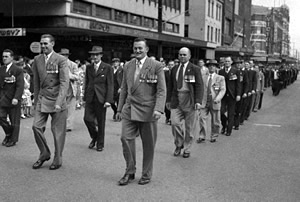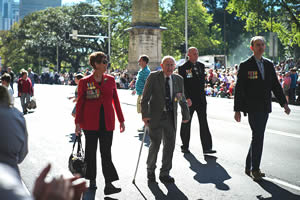English ES1
Overview

Anzac Day march, Newcastle, 1955
©Public domain (State Library of NSW)
Students explore the learning concepts of challenge, commemoration and community through the text My Grandad Marches on Anzac Day by Catriona Hay and Benjamin Johnson. Through responding to the text and images of Anzac Day marches, students draw an image to represent their ideas about Anzac Day.
Teaching and learning activities

Anzac Day March, Sydney
My Grandad Marches on Anzac Day by Catriona Hoy and Benjamin Johnson
In the story, Anzac Day is seen through the eyes of a young girl who rises early on Anzac Day to watch her grandad march in the Anzac Day parade. Jemimah relates to the little girl and her experiences. She can also relate to the little girl's grandad. She can sense his pride. She also begins to understand a little about the thousands of men and women who didn't make it home.
-
Read book and share thoughts about the girl and her grandad. How did her grandad feel about the war?
-
Focus questions: Who told this story and why? How was this story told?
-
Encourage students to share their connections to the text — grandparents, Anzac Day.
-
Students write a description of their grandad or write a letter to him.
-
View images of Anzac Day marches. Discuss feelings and thoughts about the images. Students draw an image that represents their ideas about Anzac Day.
Other Texts
Anzac Biscuits by Phil Cummings
The Little Hen and the Great War by Jennifer Beck
Anzac Ted by Belinda Landsberry
Learning concepts
These additional questions can be used for discussion or further investigations.
Challenge
What challenges did the grandad experience during the war?
How has the author helped us understand what the soldiers went through?
Community
How was community represented in the text?
Commemoration
How did the author emphasise the importance of remembrance? Why did he do this?
Syllabus links
ENe-8B demonstrates emerging skills and knowledge of texts to read and view, and shows developing awareness of purpose, audience and subject matter
Understand and apply knowledge of language forms and features
-
identify some features of texts including events and characters and retell events from a text (ACELT1578)
ENe-10C thinks imaginatively and creatively about familiar topics, simple ideas and the basic features of texts when responding to and composing texts
Respond to and compose texts
-
share feelings and thoughts about the events and characters in texts (ACELT1783)
ENe-11D responds to and composes simple texts about familiar aspects of the world and their own experiences
Develop and apply contextual knowledge
-
recognise that texts are created by authors who tell stories and share experiences that may be similar or different to students' own experiences (ACELT1575)